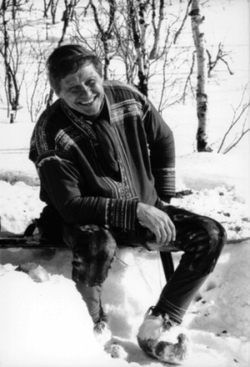- The poet
- The pictorial artist
- The musician and yoik composer
- Indigenous people’s philosophy
- The organizer, publisher and inspiration
- Lásságámmi
Mini biographies and memorials
The poet
Nils-Aslak Valkeapää received his foremost recognition as an outstanding poet when he was awarded Nordic Council’s (Nordisk Råd’s) prize in 1991 for the book The Sun, My Father. His poetry has been translated into a number of languages. It is described as close to nature and genuine, and his poetry is often referred to as an expression of indigenous people’s thinking and worldview. Valkeapää published all of his poetry books in Sámi. Several of them have not yet been translated into other languages. Besides The Sun, My Father two other central works are Pathways of the Wind and The Earth, My Mother.
Read more...
The pictorial artist
Nils-Aslak Valkeapää was known as a multimedia artist – that is, one who expressed himself through several art forms. He used to say that it was impossible for him to decide what form of expression came to him first; poetry, yoik, or illustration. Valkeapää had separate exhibitions of his art, both in Japan and China. His paintings often took their point of departure in Sámi mythological figures, while the pencil drawings/sketches often had birds, people and reindeer as motifs. Valkeapää was an outstanding photographer too, something reflected in several of his book publications.
Read more...
The musician and yoik composer
The older he became the more Nils-Aslak Valkeapää valued the traditional yoik. Valkeapää was a wholly central actor in the revitalization of the traditional Sámi yoik. Several of his publications can be characterized as yoik compositions, where the yoik goes into a higher unity of the entire musical work of art. He was awarded the Prix Italia for the composition Goase dušše (The bird symphony) in 1993. He says about the yoik’s function that it is a route to social contact. “A way to calm reindeer. To frighten wolves. The yoik is used to recall friends, even enemies.” The yoik was also a step into another world – and that makes it religious.
Read more...
Indigenous people’s philosophy
In addition to philosophy Nils-Aslak Valkeapää wrote essays. His first book was an artistic and political pamphlet in Finnish Terveisiä Lapista, 1971, translated into New Norwegian in 1979 Greeting from Sápmi. In an essay Valkeapää expresses primitive people’s philosophy of life in this way: “Another factor that unifies primitive people is their philosophy of life. Man is part of nature. Making things by hand is part of life. The cultural concept need not necessarily embrace separation and limitations. There is no ‘art’ or ‘music’. Yoik is not just music.” Both in the book The Earth, My Mother and in the play The rime-haired and the Dreamseer man’s relationship to nature is the central theme.
Read more...
The organizer, publisher and inspiration
Early in his career Nils-Aslak Valkeapää was concerned with the idea that Sámi artists should organize. He was central in the establishment of Sámi authors’ society and too that practicing artists get their own alliance. For a time he was also the culture-coordinator for the World Conference for Indigenous People (WCIP) and the main person behind what was characterized as the world’s first cultural festival for indigenous people, Davvi Šuvva in 1979. Nils-Aslak Valkeapää was always on the lookout for new Sámi talent, and helped many yoikers and writers get ahead both as a mentor, publisher and inspiration.
Read more...
Lásságámmi
Lásságámmi was Nils-Aslak Valkeapää's own name on the house he had built up in Skibotn in Troms.





